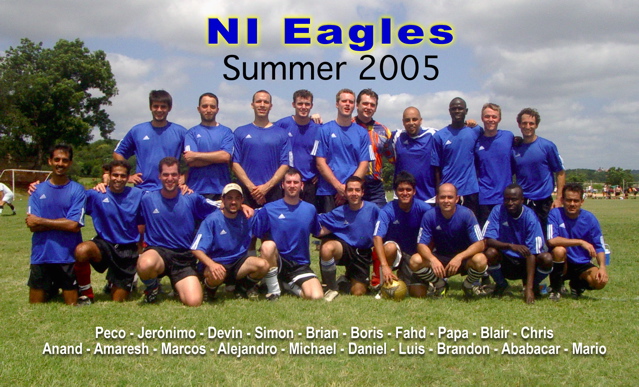Today, as speculated all over the web, Steve Jobs announced at WWDC that Apple is going to do the ultimate switch from the PowerPC processors that have been the sould of the Macintosh for a decade to x86 Intel processors.
This was a huge surprise to Apple observers around the world (myself included)… after all, if iTunes for Windows meant Hell froze, then this must surely be the Apocalypse.
Or is it?
Let me analyze some points related to this announcement. Feel free to agree, disagree, correct me or simply point out what a moron I am in the comments section.
The Mac will no longer be the Mac
Wrong. The MacIntel will look and act just like a Mac. It’s Mac OS X that makes the Mac be a Mac. If it’s using a PowerPC chip, a small Difference Engine or a hamster in a wheel, no one should care, as long as it runs Mac OS X well.
Everybody else is going PPC!
There has been lots of excitement around PPC lately, with Sony, Nintendo and (OMG) Microsoft all announcing that their next-generation videogame consoles will use PPC chips. The (mytical) Cell processor developed by IBM, Sony and Toshiba is PPC. So if the future is so bright, why is Apple going x86? Now of all times!
Well, the Cell, the Xenon and the Revolution’s processor are all PPC and they are Multimedia Monsters. That does not mean that they will be suitable for general-purpose computing. This article on Ars Technica takes a look at the Xenon CPU. They think there may not be that much horse-power for physics and AI in there after all.
Freescale (formerly Motorola) makes the G4 and they are not getting any faster. At least not quickly enough. They care about embedded and super-low power consumption stuff for other markets, not personal computers.
IBM makes the G5 and they are not getting any faster… or at least not as fast as promised. It seems like these days they care more about their own big-iron servers and the console market and not processors for personal computers. The three consoles will sell, combined, many many many more processors than Apple will. Their R&D budget is better spent where the returns will be greater, and IBM thinks it’s in the videogame market.
Intel inside
Unlike Freescale and IBM, Intel’s main income comes from personal computer chips. They have very fierce competition. And they have remained competitive, even against incredible engineering efforts by AMD and the cool technology of Transmeta (RIP). One thing is for sure with Intel… they will keep making chips for the desktop and laptop computer market. They will invest heavily or they will die. It is this kind of commitment that Apple needs and can’t get from neither IBM nor Freescale.
The Third Transition
Any self-respecting Mac user can tell you about the First and Second Transitions.
The First Transition was the one from 68k Motorola processors (used in the original Mac up until the 68040 Quadras).
The Second Transition was the one from Classic Mac OS 9 to the buzzword-compliant Mac OS X.
How will this one compare?
From a user’s standpont, the First Transition was seamless. Everything just worked. And it worked faster, even under emulation. Eventually most software went PPC-native and things ran great. PowerPC was kicking x86’s butt, we had Toasted Bunnies and everybody was happy. I don’t really know how easy or hard it was for developers. But PPC was a brand new technology that people had to learn from scratch.
The second, from Mac OS 9 to Mac OS X, was very hard for both users and developers. We had to rely on Classic a lot (which is still painful to use), there were not many native applications. Big-name applications such as Photoshop, QuarkXPrss and Office took some time to arrive. Mac OS X itself was too immature, too slow, too buggy, and too incomplete (no CD burning, no DVD playing, etc). Now, at version 10.4, Mac OS X is the most advanced OS in the world. Windows XP users don’t know what they are missing. The old painful days of the Public Beta are almost forgotten. But they were painful.
Developers had it hard too. They were forced to go back and tweak and carbonize old code that they likely didn’t write in the first place. Believe me, fixing old code is as painful for a developer as it can get (TODO: insert good analogy – use comments for any proposals), especially when they could be coding their brand new golden idea.
This time around, things should be much easier. For the user, the machine will look and act just like a Mac. PPC applications should run transparently just like they did in the First Migration through Rosetta. For developers, things should be easier too. If the developer wrote an application using
Cocoa, then he is practically just a recompile away from Fat-binary
goodness. If the application was written using Carbon, then more work is involved, but the
application should port without too much effort.
I don’t know the implications for driver developers… perhaps someone can shed some light?
Altivec is the sh*t
One of the biggest advantages of the G4 and G5 processors is Altivec. Intel processors of course don’t have Altivec, they have some sorry excuse for a vector processing unit. Will the Mac lose one of its advantages by giving up Altivec?
Not as much as you’d think (IMHO). Just look at how and who uses Altivec today:
- Apple, all over Mac OS X, especially for Quartz. With Quartz Extreme and Core Image, all the work formerly done by the Altivec unit to get those fancy drop shadows and transparent menus is now done by the graphics card. It’s been moved out of the CPU to some ATI or NVIDIA GPU, which, as you guessed, will be available on the Macintel.
- Big application developers, such as Adobe, optimize by hand and use Altivec for processor-intensive filters found in Photoshop-type applications. Well… guess what: they do this for Intel processors anyway, and those optimizations very likely will apply to the Mac version. More energy can be used now to optimize for a single chip architecture.
- Video, audio and multimedia applications: The G4/G5 was great at this. The Pentium 4 is no slouch though. I don’t think it’s a viable alternative to use the GPU for this type of thing (although it may be – do you know?) and this is an area where performance may degrade. But then again, a year from now when the first Macintel ships, this may not be the case anymore.
Episode II: The Clone Wars?
or
Finally, I can run Mac OS X on my cheap DELL!
Not so fast (no pun intended, it will probably be as fast or faster than in PPC).
The fact that Apple is using x86 processors does not mean you will be able to run Mac OS X on your cheapo home-built frankencomputer or your ugly DELL box. Apple is a computer maker. Most of its revenue and profits come from selling you desktop and laptop computers.
Remember the first Clone Wars? Apple almost went bankrupt because the clones were eating its market share instead of growing the overall Mac market share. Of course, other factors came into play: CHRP was cancelled. Windows NT for CHRP was cancelled. OS/2 for CHRP was cancelled. Copland was canceled. It’s unfair to say that the Mac OS licensing plans were flawed back then, but the failure of many related projects made licensing an unviable business for Apple at the time.
Today, while Apple depends less on computer sales than it did back then (it has a growing iPod and ITMS business and a much larger software business through Final Cut Pro and friends), it is still mainly a computer maker and this fact is not going to change soon.
So, no Mac OS X on DELL for you… at least not without lots of clever Darwin hacking and breaking your EULA.
The ace under the sleeve.
I haven’t seen this mentioned anywhere. Imagine VirtualPC or WINE on the MacIntel. Yes. You will be able to run Windoze applications in your Mac with practically no performance hit. This removes what is probably the biggest barrier to switchers.
It is also, in my opinion, a huge risk for Apple. If a developer gets requests to port a program to Mac, they may tell customers: use "Wine/VirtualPC. We don’t have the resources to port it." Hell, if it works well enough (and it will) it just might be a good answer. Well, many think this was one of the main reasons OS/2 died. For the Mac it’s less of a danger, since there is a huge number of quality software titles already (yes, huge) and the dev tools and API (Cocoa) is so good people just want to develop in it. Time will tell on this one.
Conclusion
This is neither good nor bad. This is just the best decision Apple could do given the fact that Freescale and IBM would no longer fulfill Apple’s needs.
Sure, it would have been better if we’d gotten G5s running at 3 GHz a year ago and I was writing this on a G5 Powerbook. But it didn’t happen. It’s time to move on… and remember: crazier things have happenned before.

